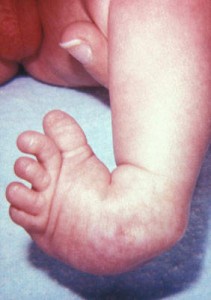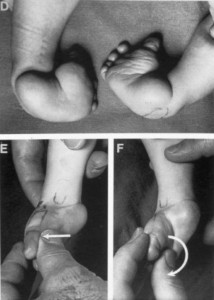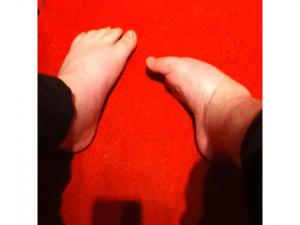Clubfoot is a defective condition that affects many infants around the world every year. Read on to know all about this disorder as well as its causes, symptoms, diagnosis and treatment.
What is Clubfoot Deformity?
Page Contents
It is a birth defect that makes the foot twists inwards and points downwards. This condition may be mild or severe. It can affect one or both foot and makes them appear as if they have turned inwards.
Medical Name for Clubfoot
This condition is medically known as Talipes Equinovarus.
Clubfoot Incidence Rate
This is a common disease that affects one out of every 1,000 babies. Every year, more than 4,000 babies in the United States are born with this defect. The condition affects boys twice more than girls.
Clubfoot Types
There are two main types of Clubfoot. These are Postural Clubfoot and Fixed Clubfoot. Fixed Clubfoot in infants may or may not require surgical correction. Bilateral Clubfoot is a more severe variation of this condition that affects both the feet of a baby. Unilateral Clubfoot affects only one foot. In kids with unilateral Clubfoot the affected foot is about 10% smaller than the normal one.
Clubfoot Symptoms
This condition mainly leads to deformity of the foot. Some of the symptoms of Clubfoot deformity are
- Feet turning backward at the subtalar joint
- Movement of foot at talonavicular joint
- Twisted ankle
The calf muscle in Clubfoot patients may be a little smaller than it happens in normal babies. If only one foot is affected, the calf muscle in that foot may be smaller than the other one of the patient. The ankle joints, ligaments, bones and muscles of the foot may turn abnormal.
Picture 1 – Clubfoot
Source – pediatrics.about.com
If both feet are affected, the soles may turn inwards. This condition does not produce any pain. It does not cause discomfort or problems in the body until he or she starts standing up and walking.
Club Foot Complications
An untreated Clubfoot may lead to severe complications. The ankle may remain twisted and the foot neither moves up nor down. Both feet are affected in 50 percent of all cases. The child walks using the upper part or the sides of the foot instead of the soles. Big, hard calluses may arise on the part of the foot that is used for walking. There can also be painful abnormalities similar to the ones that are observed in arthritic patients.
Causes of Clubfoot
The causes of Clubfoot in babies are not exactly clear. Researchers hold environmental and hereditary factors responsible for this condition. Environmental reasons include factors like cigarette smoking, drug use and infection. A medical research showed that a woman having a family history of this disease can have a twenty times more risk of giving birth to a Clubfoot baby if she smoked during her pregnancy.
Genetic factors are believed to play an important role in the appearance of this disease. A baby having this condition as a family disorder has a great chance of being born with it. Heredity is held as a cause of Clubfoot.
In some children, Clubfoot deformity occurs as a symptom of another disorder. Babies born with ‘Spina Bifida’ or Open Spine may also suffer from a variation of Clubfoot. This results from damage to the spinal nerves affecting the legs.
In some cases, babies may be born with normal legs. The defect may arise sometime later as a consequence of some nerve or muscular disease.
Clubfoot Diagnosis
Physical examination and naked eye observation by an experienced medical professional is enough to recognize this condition as well as similar defects. However, physical examination may not be enough to reveal this condition in some cases. In such situations, a healthcare provider may recommend carrying out additional medical tests such as an X-Ray.
This condition is sometimes diagnosed before birth. This generally happens during an ultrasound examination. This condition cannot be cured before birth. However, parents can consult an orthopedic surgeon about possible treatment options if this condition is revealed through an Ultrasound.
Clubfoot Treatment
The treatment for Clubfoot is generally done by different methods. These include
Casting
For curing Clubfoot casting is the main option. Also known as Clubfoot Ponseti Method or Serial Casting for Clubfoot, it is the most common treatment option for this condition in the United States. Casting generally cures this condition in two to three months. Treatment should begin as early as possible, preferably in the first few weeks after the birth of the infant. The tendons and ligaments in the foot are very tender at this age and therefore react well to treatment. According to medical studies, casting can also successfully cure clubbed feet in kids older than a year and who have not received any medical treatment for the disease since birth.
The process involves putting the foot of the infant in a plaster cast and holding it in the adjusted position. The cast usually extends down to the toes from the upper part of the thigh. The doctor takes off the cast after every five to seven days, manipulates the foot and again inserts it into a fresh cast. Each casting and manipulation attempts to bring the affected foot to a normal condition. A clubbed foot needs several casts for complete correction. Affected babies often have to wear the cast for several months after cure to ensure that their foot remains in normal position. This is the most accepted method of treating the condition.
Physical Therapy
An alternative to casting is manipulation of the affected foot. A physical therapist gently manipulates the impacted foot of the baby on a daily basis for about two months. The manipulation is done less frequently until the infant becomes at least six months old. The affected foot is taped after every session to hold the corrected posture in place. After physical therapy ends, the baby has to wear a spilt in the affected foot at night. This continues until the baby becomes old enough to walk.
Surgery
With newer approaches like casting and physical therapy coming into practice, the need for Clubfoot surgery has greatly reduced these days. Surgery for Clubfoot was once the only option for correcting long-term complications such as stiffness and pain of ankle and foot. Clubfoot repair surgery for an infant with one or more clubbed foot should be carried out by an orthopedic surgeon who has previous experience in treating babies with this condition. Clubfoot surgery cost is also high which makes it difficult for patients with normal financial status to afford it. However, thirty to fifty percent Clubfoot patients never respond to non-surgical treatment and require an operation for foot correction.
Shoes for Clubfoot
If treatment is carried out early and by expert hands, most children suffering from severe cases of clubfoot can grow up to be able to wear regular shoes. In some cases however, a shoe for the clubbed foot is usually 1 to 1½ sizes smaller than one for the unaffected foot. The calf of the affected foot also appears marginally thinner. The variation is minimal and has no effect on functioning of the foot.
Clubfoot Pictures
Want to check how a foot affected by this condition looks like? Here are some useful Clubfoot images for you. Check out these pictures of Clubfoot and know about the visual appearance of this condition.
Picture 2 – Clubfoot Image
Source – emedicine.medscape.com
Picture 3 – Clubfoot Picture
Source – clubfeet.net
With early treatment, infants with Clubfoot can get cured fast. They may also participate in sports and lead an active life just as anyone without the condition. If you know anyone with such a condition, seek immediate medical treatment to cure him or her as soon as possible.
References:
http://www.marchofdimes.com/birthdefects_clubfoot.html
http://www.ncbi.nlm.nih.gov/pubmedhealth/PMH0002208/
http://en.wikipedia.org/wiki/Club_foot
http://www.wisegeek.com/what-is-a-club-foot.htm



